Indiana Beach – Monticello, Indiana
There’s nothing quite like Steel Hawg. It’s not just the extreme and the bizarre (and the extremely bizarre) elements found throughout the layout, although those certainly go a long way in establishing its own brand of uniqueness. It’s the way it paces itself between those elements that’s at odds with any other roller coaster devised. The high speed segments nearly all denote the less thrilling parts of the ride, and it’s when it slows down that things start to get interesting. Other coasters achieve g-forces through accelerational motion; Steel Hawg achieves g-forces the old fashioned way, with unfiltered gravity tugging on our bones. The ways it goes about doing that are kind of ingenious, but we’ll get to that shortly.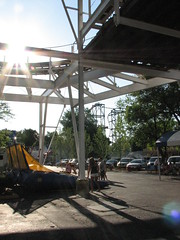
The coaster’s location is rather odd. Cross underneath the Hoosier Hurricane along the log flume lift towards what was once the outer perimeter of the park and you’ll discover a brand new midway, which I think was originally a road/parking lot around the park. I forget if there ever was much of a clear divide between park and parking lot back then, since the pathways beneath the elevated Hoosier Hurricane station just sort of lead off into the streets that the hotels and other shops were found along; there never being a clear indication of when one was actually inside the park boundaries until they stopped seeing boutiques and started seeing coasters (there probably was a gate of some kind however because until 2009 they had a small entry fee to walk the grounds). Anyway, so they’ve reclaimed some of the surrounding residential property for strictly park use, and Steel Hawg is found at the far end of a long midway shuttled between the log flume on one side and houses on the other.
I hope they’ll find more to build along this midway because right now Steel Hawg’s placement feels like the solution to a RollerCoaster Tycoon scenario than part an actual park, although they did dress the pathway up nicely for their Halloween Beach Bash event,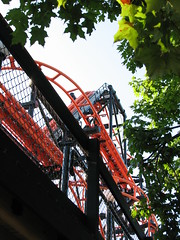 which was when I finally got to ride Steel Hawg after it spent most of its debut weekend down (most of these pictures are from that July visit however). And what great lines we had; walk-ons for everything, at least everything that was open. The day started with Galaxi and Lost Coaster out of commission and then Tig’rr went down late-afternoon, and Steel Hawg had an e-stop that shut it down just before sundown, leaving a night to ride just Hoosier Hurricane and Cornball Express (not complaining about that one bit, however the cold weather did leave both running quite sluggish and I had to pick the icicles off my nose when we got back in the station after each re-ride). Indiana Beach decided to discontinue their Halloween event after that one year, which doesn’t surprise me at all given the low turnout I saw that day, but I hope they give it another shot sometime as the park was very peaceful and serene in autumn.
which was when I finally got to ride Steel Hawg after it spent most of its debut weekend down (most of these pictures are from that July visit however). And what great lines we had; walk-ons for everything, at least everything that was open. The day started with Galaxi and Lost Coaster out of commission and then Tig’rr went down late-afternoon, and Steel Hawg had an e-stop that shut it down just before sundown, leaving a night to ride just Hoosier Hurricane and Cornball Express (not complaining about that one bit, however the cold weather did leave both running quite sluggish and I had to pick the icicles off my nose when we got back in the station after each re-ride). Indiana Beach decided to discontinue their Halloween event after that one year, which doesn’t surprise me at all given the low turnout I saw that day, but I hope they give it another shot sometime as the park was very peaceful and serene in autumn.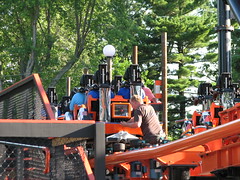
But this is a ride analysis, not a park report. So let’s start in the station. They only had two trains running, which was more than enough for that day (many empty cars had to be cycled so they could get people back in the station). The UK clone Mumbo Jumbo is supposed to run with five cars instead of four, which I really don’t see how that will happen unless they’ve expanded the loading platform to accommodate more than one car at a time. The cars are really souped-up wild mice vehicles, and I mean really souped-up. It would almost appear that 60% of the mass is comprised of the seats, the chassis being very low-slung and aerodynamic, two flames running down each side of the car. The seats are the same style found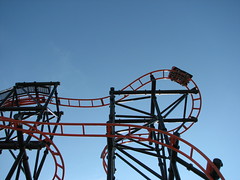 on most other recent S&S installations, a very deep, angular fold with a suggestive leg-divider, not the most ergonomic design for anyone who is not a trained gymnast, but they still work decently enough. The lapbar comes down from the side à la Phantom’s Revenge (although these have the benefit of ratcheting downwards further instead of having a fixed pivot point) and then a curious set of over-the-shoulder bars pull straight down from overhead (these need an operator’s assistance). But it somehow is comfortable for the most part, eliminating the risks of head banging, while at the same time feeling decidedly off-kilter. My subconscious is telling me “this isn’t how restraining systems are supposed to feel if they’re working right”, putting me at slight unease before we’ve even left the station.
on most other recent S&S installations, a very deep, angular fold with a suggestive leg-divider, not the most ergonomic design for anyone who is not a trained gymnast, but they still work decently enough. The lapbar comes down from the side à la Phantom’s Revenge (although these have the benefit of ratcheting downwards further instead of having a fixed pivot point) and then a curious set of over-the-shoulder bars pull straight down from overhead (these need an operator’s assistance). But it somehow is comfortable for the most part, eliminating the risks of head banging, while at the same time feeling decidedly off-kilter. My subconscious is telling me “this isn’t how restraining systems are supposed to feel if they’re working right”, putting me at slight unease before we’ve even left the station.
 The train dispatches into a tight right curve before engaging the lift. This lift is fast, getting us to the top in a hair over ten seconds. Notice anything else that feels a bit not-right? Maybe it’s that when we crest the top we realize despite the short lift we somehow managed to get very high up. To people on the right side of the car: enjoy the vertigo as you get a panoramic view of the surrounding beachside villas when the car sharply navigates around the upper turn. Pulling out of the curve we see there’s no track in front of us.
The train dispatches into a tight right curve before engaging the lift. This lift is fast, getting us to the top in a hair over ten seconds. Notice anything else that feels a bit not-right? Maybe it’s that when we crest the top we realize despite the short lift we somehow managed to get very high up. To people on the right side of the car: enjoy the vertigo as you get a panoramic view of the surrounding beachside villas when the car sharply navigates around the upper turn. Pulling out of the curve we see there’s no track in front of us.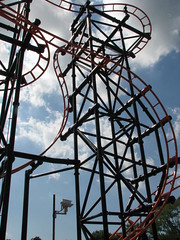 The train just sort of nose-dives downwards, not really falling like most drops, but more of a simulation of a pop-star taking a face plant off the side of the stage. Some people might complain about the brakes along the top of the crest, but they actually make this drop an even stranger flavor of weird than we might have otherwise gotten; the sense of steepness is greatly exaggerated as we’re forced forward, and then out of the restraints as the car curls underneath the track above it. I had to hold my legs in to keep them from coming up out of the car on this one, turning what’s normally a passive activity into an interactive physical experience while highlighting just how real and tangible this situation is. In a lot of other extreme coaster experiences the blistering speed and forces can put me in a state of unreality, as if I’m riding in the hand of God. The opposite is true on Steel Hawg, I very much am aware of my own fragile existence on this ride, probably because it’s so tight that my physical body mass covers a large percentage of the actual turning radius.
The train just sort of nose-dives downwards, not really falling like most drops, but more of a simulation of a pop-star taking a face plant off the side of the stage. Some people might complain about the brakes along the top of the crest, but they actually make this drop an even stranger flavor of weird than we might have otherwise gotten; the sense of steepness is greatly exaggerated as we’re forced forward, and then out of the restraints as the car curls underneath the track above it. I had to hold my legs in to keep them from coming up out of the car on this one, turning what’s normally a passive activity into an interactive physical experience while highlighting just how real and tangible this situation is. In a lot of other extreme coaster experiences the blistering speed and forces can put me in a state of unreality, as if I’m riding in the hand of God. The opposite is true on Steel Hawg, I very much am aware of my own fragile existence on this ride, probably because it’s so tight that my physical body mass covers a large percentage of the actual turning radius.
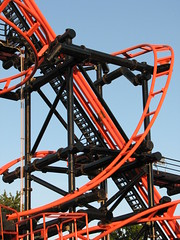 The pullout is fast, but my real dread comes from what’s next: an impossibly sharp left hand curve. Just look at the photo. From offride it looks nuts. It seems to go from a straight-up vertical slope to pitch around 90 degrees both horizontally and to the side in the space of about two cross-ties. How this element works without neck-breaking laterals was beyond me, but somehow the car always seems to glide around it with carefree ease, the passengers more jarred by a quick grab on the first block brake than by anything experienced on that turn.
The pullout is fast, but my real dread comes from what’s next: an impossibly sharp left hand curve. Just look at the photo. From offride it looks nuts. It seems to go from a straight-up vertical slope to pitch around 90 degrees both horizontally and to the side in the space of about two cross-ties. How this element works without neck-breaking laterals was beyond me, but somehow the car always seems to glide around it with carefree ease, the passengers more jarred by a quick grab on the first block brake than by anything experienced on that turn.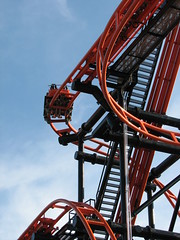 I still can’t really explain the physical dynamics behind this curve, other than it’s not as sharp when viewed from different angles; I must hand it to the designers at S&S because this was one of those moments I would not have been surprised to see them pull a Maverick and re-design it after realizing their math wasn’t quite right or something.
I still can’t really explain the physical dynamics behind this curve, other than it’s not as sharp when viewed from different angles; I must hand it to the designers at S&S because this was one of those moments I would not have been surprised to see them pull a Maverick and re-design it after realizing their math wasn’t quite right or something.
Steel Hawg’s layout is divided into thirds, each with its own distinctive flavor while still sort of mirroring the established pace found in the other two. The first third now behind us, we start into the second, and in my opinion best part of Steel Hawg. It starts with an outward banked turn high above the ground, something I’m somewhat surprised has taken this long for a designer to actually implement, although I can understand why since theoretically laterals should be quite brutal. Despite some fears that the ride might be too similar to the heavily braked Screamin’ Squirrels,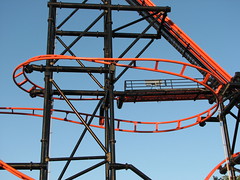 Steel Hawg actually lets it rip around this first turn alarmingly fast. But like the turn before it, I was surprised by the relative lack of laterals around this turn. They still are very present, the laterals at this moment should be punishing and instead they’re just ‘there’ pulling on us. It might be steeply enough banked that a lot of the lateral forces start to get converted into negatives, the mixture of which combine to make this possibly the craziest element on the ride.
Steel Hawg actually lets it rip around this first turn alarmingly fast. But like the turn before it, I was surprised by the relative lack of laterals around this turn. They still are very present, the laterals at this moment should be punishing and instead they’re just ‘there’ pulling on us. It might be steeply enough banked that a lot of the lateral forces start to get converted into negatives, the mixture of which combine to make this possibly the craziest element on the ride.
How it progresses from this turn demonstrates a true wunderkind in design. After rotating into one far extreme (the outward banking) it naturally flows around the center of gravity, tipping us back upright around the exit. However, the rotation of the car continues at the same, leisurely pace, and from that 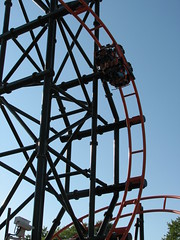 outward banked turn it shifts immediately into the next logical progression, a severely over banked inward turn that pivots us forward while hanging us from our other side. It continues the same rate of rotation until we’re hanging all the way upside down. By taking this element apart we can see that it layers a standard downward helix together with the centerline rotation found in a heartline roll, the aggregate effect being an element that feels at once perfectly absurd and yet perfectly natural. Not one moment feels discontinuous from the last, but our sense of orientation has been totally confounded.
outward banked turn it shifts immediately into the next logical progression, a severely over banked inward turn that pivots us forward while hanging us from our other side. It continues the same rate of rotation until we’re hanging all the way upside down. By taking this element apart we can see that it layers a standard downward helix together with the centerline rotation found in a heartline roll, the aggregate effect being an element that feels at once perfectly absurd and yet perfectly natural. Not one moment feels discontinuous from the last, but our sense of orientation has been totally confounded.
After the continuous rotational flow from one extreme to the other, it suddenly stops dead, leaving us hanging from our shoulders (gotta work to keep those feet in the car again!) upside down some sixty feet above the ground. After holding us upside down perhaps a moment too long, the car falls straight down once again with the inverted dive loop. This moment is just fun, turning a stand-still moment of intense hangtime into a very dynamic moment of weightless freefall as our inner ears try to keep track of the 180 gravitational flip. I think the highest speed might be attained on the pullout, a fitting crescendo to the intense but slow build-up that preceded it. The second part of the 3-part ride concludes with a solid punctuation mark: a quick boost of smooth air after the fast rise back up into the final block brake.
Like the previous two sections, this one starts out kind of slow and unassuming but soon wryly contorts in and around itself an unpredictable manner, culminating in a unique moment of hangtime before bursting out with a moment of speed and then quickly tapers off again. We get a quick, banked right-hand turn, the shift around the heartline as we go into it producing a groovy little effect to get back into the pace of the coaster. We twist again around the heartline on the way out, but we instead keep on twisting all the way around into a descending inline twist. The view just before we do is quite unforgettable, looking straight down a barrel of orange track and realizing we’re going to have to navigate through that right this moment. The roll itself isn’t as fluid an element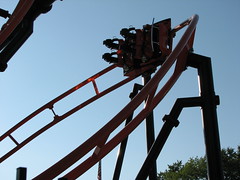 as I might have hoped for. The constantly shifting gravity creates a unique form of hangtime, but it feels awkward and highlights the pressure points in the restraining system while the top-heavy cars can be felt shunting around on the track a bit.
as I might have hoped for. The constantly shifting gravity creates a unique form of hangtime, but it feels awkward and highlights the pressure points in the restraining system while the top-heavy cars can be felt shunting around on the track a bit.
 It does build speed nicely, which has the added effect of increasing the rate of rotation throughout the roll, and on the pullout it quickly shifts the rolling motion in an opposite direction as it surges up and around the final wall turn. I believe this turn was originally supposed to look more like those found on the Maurer spinners but it wouldn’t have enough speed, so it was modified to appear more like a traditional overbank. It works just fine as it is, offering a cool little rotational twist into the curve where it holds us against the track for a moment before twisting and falling back out. It also works as a good conclusion to the coaster, being the first moment that finally feels more like a traditional element that gets forces from the usual types of dynamic changes rather than the strange deviations of hangtime at low speeds the rest of the ride subjected us to.
It does build speed nicely, which has the added effect of increasing the rate of rotation throughout the roll, and on the pullout it quickly shifts the rolling motion in an opposite direction as it surges up and around the final wall turn. I believe this turn was originally supposed to look more like those found on the Maurer spinners but it wouldn’t have enough speed, so it was modified to appear more like a traditional overbank. It works just fine as it is, offering a cool little rotational twist into the curve where it holds us against the track for a moment before twisting and falling back out. It also works as a good conclusion to the coaster, being the first moment that finally feels more like a traditional element that gets forces from the usual types of dynamic changes rather than the strange deviations of hangtime at low speeds the rest of the ride subjected us to.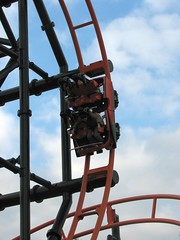
Steel Hawg is probably the only coaster I know of (besides the Screamin’ Squirrels) that places a central emphasis on hangtime above all other g-forces. It’s found at three points along the layout, each the strategic centerpiece of its portion of the ride that’s found between midpoint blocking pauses, and each are a distinct flavor from the other. The first moment is on the first drop, achieved from the very steep forward pitch combined with the slight braking. Next is the big moment, on the inverted dive loop, where the hangtime is held without any competing sensations for a second or two. The last is on the barrel roll, where the hangtime is achieved by the rotation sideways around the axis. Besides some of the pullouts, some scant laterals, and pop up into the second block brake, there really aren’t many real g-forces along the ride, just places where the car places the rider in a peculiar orientation with respect to gravity (and remember, hangtime is basically the equivalent to -1 g forces which only a small handful of rides like El Toro or Maverick are able to exceed using conventional uplift forces).
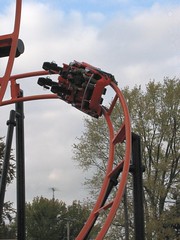 This may sound silly in a year when other rides such as Fahrenheit, Behemoth and Ravine Flyer II opened but I personally think that Steel Hawg may have been the strongest new attraction for 2008. While these are qualities I normally associate with ambitious, 4000+ ft. long roller coasters, this coaster packs a wide range of sensations and is able to do it with a logical sequencing to the elements despite its short ride time and small footprint. Not since Schwarzkopf practically invented the genre back in the 1970’s and 80’s with formal masterpieces such as Thriller or Olympia Looping has a compact coaster truly excited me not just as a great ride but as a complete experience rather than a simple engineer’s gimmick. That said, the ride is not perfect… it is over rather quickly, and while the odd approach to g-forces, dynamic contrasts and just about everything else might be off-putting to some, it at least distinguishes it in a marketplace
This may sound silly in a year when other rides such as Fahrenheit, Behemoth and Ravine Flyer II opened but I personally think that Steel Hawg may have been the strongest new attraction for 2008. While these are qualities I normally associate with ambitious, 4000+ ft. long roller coasters, this coaster packs a wide range of sensations and is able to do it with a logical sequencing to the elements despite its short ride time and small footprint. Not since Schwarzkopf practically invented the genre back in the 1970’s and 80’s with formal masterpieces such as Thriller or Olympia Looping has a compact coaster truly excited me not just as a great ride but as a complete experience rather than a simple engineer’s gimmick. That said, the ride is not perfect… it is over rather quickly, and while the odd approach to g-forces, dynamic contrasts and just about everything else might be off-putting to some, it at least distinguishes it in a marketplace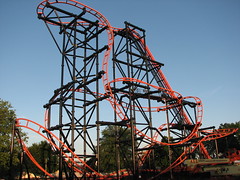 that has become oversaturated with coasters whose definition of creativity is limited to pond splashes and overbanking. It is a perfect fit for Indiana Beach despite the odd location, as that park has always been defined by its idiosyncratic traditions (it’s an Atlantic boardwalk in the middle of Indiana, after all) and they needed a headlining steel coaster to stay competitive. The name is just about perfect too, seeing as their other star attractions have names like the Cornball Express. I think when I tabulated my top twenty lists I found a comfortable spot for Steel Hawg on it, not quite near to the best of them, but my highest rated production model compact coaster at least.
that has become oversaturated with coasters whose definition of creativity is limited to pond splashes and overbanking. It is a perfect fit for Indiana Beach despite the odd location, as that park has always been defined by its idiosyncratic traditions (it’s an Atlantic boardwalk in the middle of Indiana, after all) and they needed a headlining steel coaster to stay competitive. The name is just about perfect too, seeing as their other star attractions have names like the Cornball Express. I think when I tabulated my top twenty lists I found a comfortable spot for Steel Hawg on it, not quite near to the best of them, but my highest rated production model compact coaster at least.
If you have version 1.6 or later of the NoLimits Roller Coaster Simulator, check out this very detailed Steel Hawg re-creation (click on photo below to download). Photos of the development process can be found here.
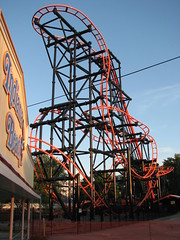
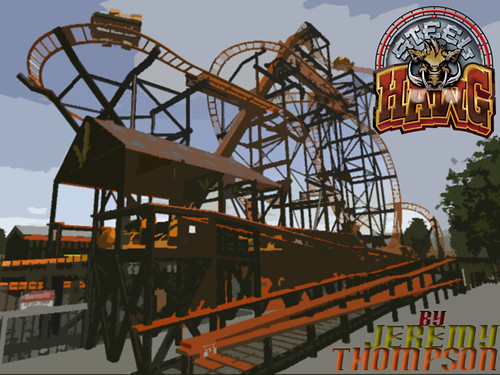
Comments